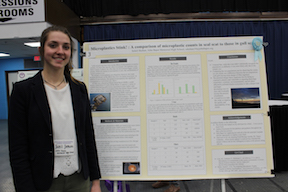2019 MSWC Winning Student Poster Highlight: Microplastics Stink! A Comparison of Microplastics Pollution
Microplastics Stink! A Comparison of Microplastics Counts in Seal Scat Compared to Gull Scat
High School
Soleil Skehan, John Bapst Memorial High School
Honorable Mention

Pollution in air and waterways has been contaminating our environment for decades, threatening the stability of ecosystems across the globe. An increasingly growing concern, however, has risen surrounding microplastics, specifically their presence in marine ecosystems.
Soleil Skehan, a senior at John Bapst Memorial High School in Bangor, Maine, explored this topic by conducting an experiment in August 2018 on Mount Desert Rock, a small, rocky research island located 25 miles off the coast of Maine. She presented a poster about her work at this year’s Maine Sustainability & Water Conference receiving an Honorable Mention from the judges.
According to Skehan, not much research has been conducted concerning the effects of these microplastics on marine life, but it is known that their presence is affecting marine ecosystem organisms across the board. Plastic debris can come in all shapes and sizes, but those that are less than five millimeters in length—about the size of a sesame seed—are called “microplastics.”
Microplastics come from a variety of sources, including from larger plastic debris that degrades into smaller and smaller pieces. In addition, microbeads, a type of microplastic, are very tiny pieces of manufactured polyethylene plastic that are added as exfoliants to some health and beauty products, such as some cleansers and toothpastes. These tiny particles easily pass through water filtration systems and end up in the ocean and Great Lakes, posing a potential threat to aquatic life.
Why did Skehan choose to sample the scat of seals and gulls?
“There are huge populations of both on the island and, because we were so remote, while the species on the island are diverse the seals and gulls are the biggest animals making it possible to get enough of their scat to analyze over a short period of time,” Skehan said.
All scat samples were collected and kept frozen until a sieving process that separated fine particles from more course particles began. After sieving through each sample, chemical analyses were used to digest all biological material while avoiding degradation of the plastic particles. The final step in the process was analyzing each sample under a microscope and recording counts of plastic particles in each.
Reported Skehan, “We did find high counts in both the seal and gull samples in just 6 milliliters of solution from the original sample, and we found over 600 beads in one of the gull samples. While the seal counts overall were lower they were still relatively high based on their diet and the location of the island.”
Skehan noted that this was her first research experience and while she has no plans to continue research along the same lines as the microplastic project, she hopes to go into a field that incorporates some research work. “This project was an aside and I plan to pursue some neuroscience and music combination to do some sort of music therapy. Skehan plans to attend St. Ansel’s College in Manchester, NH to begin her college career.
